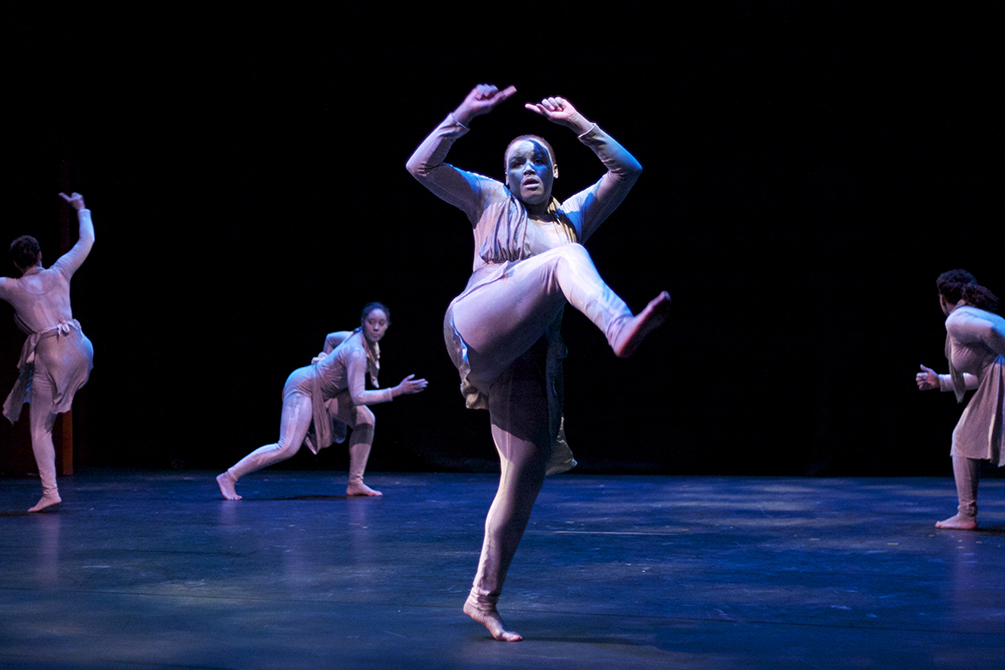
Five women in hooded jumpsuits, four in blue and one in white, rise from the floor as the light that illuminates them grows in intensity. Each woman commands attention in turns, one executing balletic turns and leaps, another raising her leg in the air with yogic concentration. The woman in white begins to dance, but is cut short when she suddenly crumples to the floor.
So begins “Gone 2 Soon,” a piece choreographed and performed by the all-female Red Clay Dance Company, which took to the Logan Center’s Performance Hall stage to present their fifth anniversary concert, “Transcending,” on October 18. The Hyde Park–based dance troupe’s mission is to spur what they call “glocal” (a portmanteau of “global” and “local”) change, by “creating, performing, and teaching African Diaspora–inspired work.” Set to the driving rhythms of music from Brazil and Guinea, their work is broad in scope, drawing on both the anguish of uprooted Africans transported across the Atlantic as slaves and the recent Trayvon Martin case. But the group is also firmly rooted in Chicago’s dance scene: three of the troupe’s five main dancers attended Columbia College to study dance, and the group leads dance education programs for teenagers on the South Side.
Including “Gone 2 Soon,” the last of the three sets, “Transcending” featured two pieces that are produced and performed entirely by the dance troupe. The company opened the program with the world premiere of “On Hallowed Ground,” a dance choreographed jointly by the performers and Vershawn Sanders Ward, Red Clay’s founder and artistic managing director. The piece takes its central imagery from an underwater sculpture off the coast of Grenada.
In the sculpture, “Vicissitudes,” figures stand in a ring facing outward, an arrangement that is echoed in Sanders Ward’s piece, which commemorates the slaves of the Middle Passage. Accompanied by the droning of electric cellos, the five women move sinuously, painted a statuesque gray from head to foot and clad in short, flowing dresses. The women writhe against a metal chain that connects and binds them, their movements conveying the horrors of captivity and a longing for freedom. As the dancers sway, a voice narrates the story of a child waiting in vain for her parents, discovering in their place a man she doesn’t know. The dancers’ movements express a caged desperation, made most vivid by moments when a single dancer would leap into the air, only to be caught mid-jump by her fellow performers. The piece ends as the five lie onstage in defeat, gasping as though they’ve been drowned.
The grim mood was broken by “My Sister’s Keeper,” performed in collaboration with the all-female Ayodele Drum and Dance group. As a line of women beat the drums that sit before them, their hair bound up in white cloth, other women in beaded skirts execute an intricate sequence of steps, creating flurries of movement. The two groups seem united in sisterhood as they synchronize their rhythms, yelling and drumming exuberantly. All involved are smiling broadly. Watching, it was hard not to smile too.
But Red Clay doesn’t shy away from tackling emotionally fraught topics, and after this brief celebratory respite, the concert closed with “Gone 2 Soon.” In their loose-fitting hooded jumpsuits, the dancers directly evoked the Trayvon Martin case, which inspired the piece. Instead of focusing on the political ramifications of the tragedy, Sanders Ward transforms the shooting into an elegiac dance that explores the emotional aftereffects of loss as a general phenomenon. The piece seemed to follow the classic “five stages of grief,” with musical fragments (including a snippet from Stevie Wonder’s “Never Dreamed You’d Leave in Summer”) emphasizing the shifting moods of each stage.
The three pieces of the concert spanned a broad emotional spectrum, ranging from desperate to joyous to sorrowful. But Red Clay Dance managed to collect these disparate threads, as varied as the legacy of the African Diaspora itself, and weave it into a cogent, expressive whole, a message of proud resilience in the face of adversity. In the closing moments of “Gone 2 Soon,” the dancers continue to dance even after the music fades away, and their breathing is the last thing we hear before the stage fades to black. A spotlight appears, and the woman in white steps into it. She stands upright, a show of defiance.
